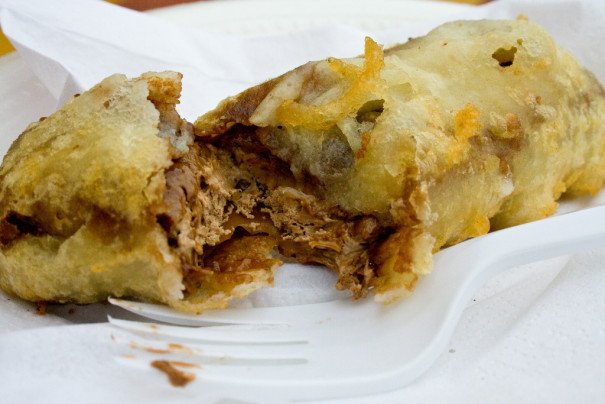
Mission to Mars

Mission to Mars
Deep Fried Mars Bar in Scotland
The oil of the deep fat fryer burbles and spits. I dip the chilled Mars bar into the gloopy batter, splash it around and watch the mixture seep around its contours. The room smells of stale fat. With an inexperienced jerk I plunge the bar into 200 degrees of seething oil. It froths up and sounds like an underwater jet. I see the batter begin to crinkle and corrugate, the dripping gunk turn golden and crisp.
When I take it out, it oozes out melted chocolate, it expands and then quickly puckers in the atmosphere. I put it on a plate and leave it to rest: dark and ugly. My own, and very first, home-made deep-fried Mars bar. And although it looks foul, and unfortunately fecal-like, it is surprisingly edible; like a richer, nuttier and gooier banana tempura. I’m pleasantly surprised—that is until 10 minutes later, when all initial disbelief is replaced by a churning stomach and a heavy, greasy lethargy.
This is no breakfast for old men. No breakfast for youth. No breakfast for a hangover or a celebration. Though I ate it the early hours, it is no breakfast at all. This scorned, Scottish heart attack of chocolate and grease was cited by The Economist as among one of the many reasons for the city of Glasgow’s low life expectancy. Each battered bar contains around 1,000 calories, is high in saturated fats and sugar, and, according to some of Scotland’s “finest” tabloid newspapers, can cause a stroke moments after consumption.
The idea was born in a vat of oil in the town of Stonehaven in 1995, when the Haven, now called the Carron Fish Bar, began serving the deadly delicacy to local school children on request. The story was picked up by the local press and only five days later—such was the mixture of outrage and curiosity among the public—the “treat” was being broadcast to the nation via the BBC. In 2004 Scotland’s noxious indulgence broke America on the Jay Leno show and the country’s ignominious role as the “sick man of Europe” was cast.
Mars have of course disowned the product, stating, in a declaration dripping with irony, “that deep-frying one of [its] products would go against [its] commitment to healthy, active lifestyles.” The company was, however, “flattered that customers of Carron Fish Bar liked [its] product so much that it had become a bestseller in the store.” Flattered or not, the brand demanded that Lorraine Watson, owner of the Carron Fish Bar, put a disclaimer in the shop’s window distancing the calorific creation from the company’s more salubrious ethos. And Watson, for fear of legal action (but probably to greater sales of deep-fried Mars bars), did so.
In spite of international perceptions and commercial anxieties, the deep-fried Mars bar does not form a staple part of the Scottish diet. A study conducted by The Lancet in 2004 showed that only 22% of the nation’s fish and chip shops sold deep fried Mars bars and that average sales of the product reached a meagre 23 bars per week. Even at the bar’s flagship store, of the 150 bars Lorraine Watson estimates she sells per week, at least 70% are sold to visiting gastronomes or flippant tourists. I for one, a Scot who should have been gobbling at least 7 per day, had never even seen a deep-fried Mars bar until I made my own a few days ago. Indeed, this chocolatey coronary, although guaranteed to raise your bad cholesterol and blood triglyceride levels, is more guilty pleasure than toxic takeaway.